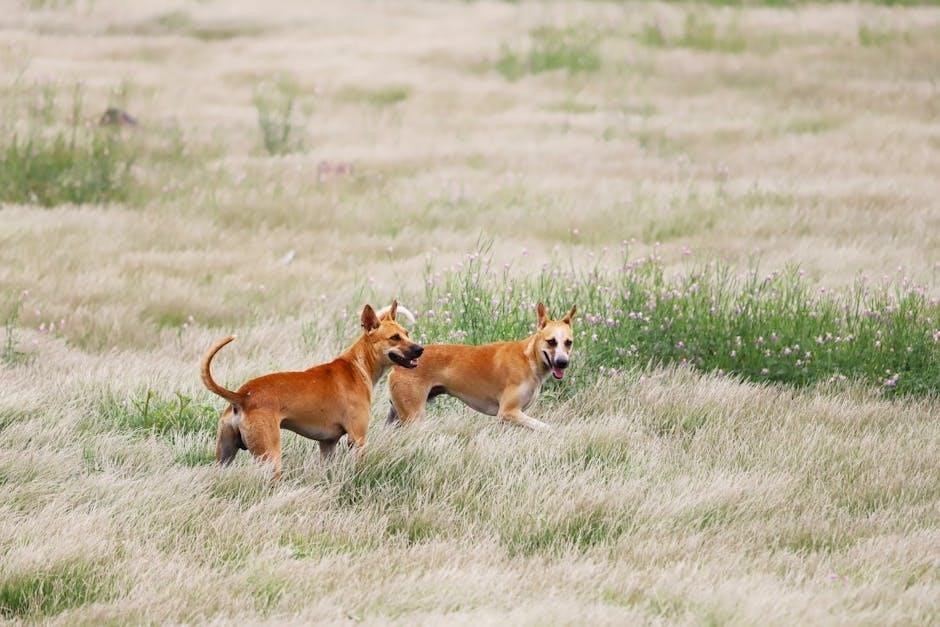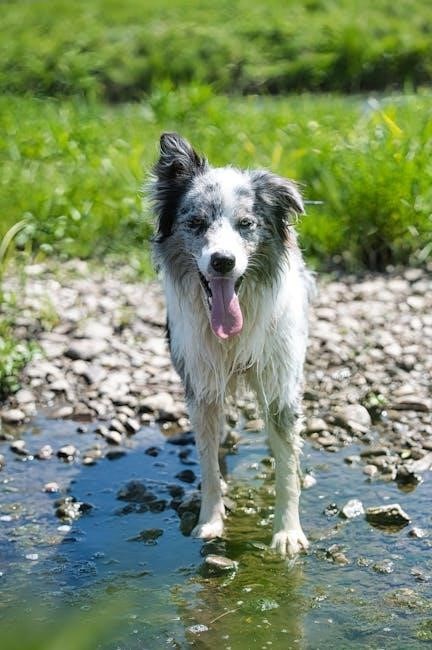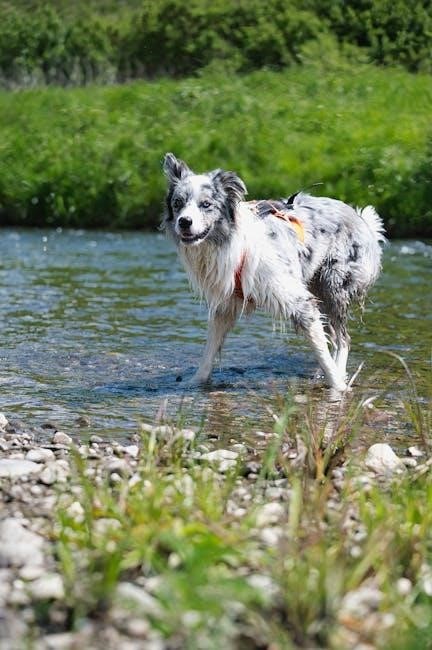Pre-spay instructions ensure your dog’s safety, smooth recovery, and reduce stress, preparing them for surgery and promoting a successful outcome by following essential guidelines.
1.1 Importance of Pre-Spay Preparation
Pre-spay preparation is crucial for ensuring your dog’s safety and reducing surgical risks. Proper fasting, vaccinations, and health screenings minimize complications. Following guidelines helps prevent anesthesia-related issues and promotes a smooth recovery. Preparation also reduces stress for both pets and owners, ensuring the procedure is safe and successful. Adhering to pre-spay instructions is essential for optimal outcomes and your dog’s overall well-being.
1;2 Overview of the Spay Surgery Process
Spay surgery is a routine procedure where a veterinarian removes the reproductive organs to prevent breeding and reduce health risks. The process involves anesthesia, surgical incision, and careful monitoring. Owners receive post-operative care instructions, including pain management and activity restrictions. The surgery is performed by licensed professionals to ensure safety and effectiveness, promoting long-term health benefits for your dog.

Vaccination Requirements Before Spay Surgery
Vaccinations are crucial for preventing infections and ensuring your dog’s safety during spay surgery. Core vaccines must be up-to-date at least two weeks before the procedure;
2.1 Necessary Vaccines for Dogs
Necessary vaccines for dogs before spay surgery include rabies, distemper, parvovirus, and adenovirus. These protect against life-threatening diseases and are required for safe anesthesia and recovery. Your vet may also recommend others based on your dog’s lifestyle and risk factors. Ensuring up-to-date vaccinations helps prevent complications and ensures a smooth surgical experience for your pet.
2.2 Timing of Vaccinations Relative to Surgery
Vaccinations for dogs should be completed at least two weeks before spay surgery to ensure immunity is established. This timeframe minimizes the risk of complications and ensures your dog is protected during the procedure. Vaccines administered too close to surgery may not be fully effective, so proper timing is crucial for your dog’s safety and recovery.

Preoperative Fasting Guidelines
Dogs must stop eating after midnight the night before surgery, but water is allowed until arrival. An empty stomach is crucial for safe anesthesia administration.
3.1 Food and Water Restrictions
Dogs must stop eating after midnight the night before surgery, but water is allowed until arrival. Food restrictions prevent anesthesia complications, while water keeps them hydrated. Adhere strictly to these guidelines for a safe procedure.
3.2 Exceptions for Puppies Under 4 Months
Puppies under 4 months may still eat and drink normally as their young age requires consistent nutrition. However, always consult your veterinarian for specific instructions, as some may recommend limited fasting. Ensure their safety and comfort by following tailored guidelines for young dogs.
Health Checks and Pre-Surgical Screenings
Pre-surgical health checks ensure your dog is fit for anesthesia and surgery. These screenings detect potential health issues and allow adjustments to the surgical plan.
4.1 Importance of Pre-Anesthetic Screening
Pre-anesthetic screening is crucial to ensure your dog’s safety. Blood tests and physical exams detect underlying health issues, helping veterinarians tailor anesthesia plans and minimize risks. This step prevents complications and ensures the procedure is as safe as possible for your pet.
4.2 Health Conditions That May Affect Surgery
Certain health conditions, such as heart disease, diabetes, or obesity, can impact your dog’s surgery. Pre-anesthetic screening helps identify these issues, allowing veterinarians to adjust anesthesia or surgical plans. Conditions like infections or bleeding disorders may also require special attention to ensure your dog’s safety during the procedure.
Drop-Off and Admission Procedures
Recommended check-in times are typically between 8 a.m. and 9 a.m. Car-side check-in processes are often available for convenience, ensuring a smooth admission.
5.1 Recommended Check-In Times
Most clinics recommend arriving between 8 a.m. and 9 a.m. for spay surgeries. Arriving within this window ensures a smooth process and avoids delays. Late arrivals may result in rescheduling. Always confirm check-in times with your vet to accommodate their specific schedule and procedures. Timely arrival helps ensure your dog’s surgery begins as planned, minimizing stress for both you and your pet.
5.2 Car-Side Check-In Process
Arrive curbside at the designated time and remain in your vehicle. Clinic staff will meet you to assist with paperwork and escort your dog. Ensure all required documents are ready. This process minimizes wait times and reduces stress for your dog. Call the clinic upon arrival to notify staff of your presence. Follow their instructions for a smooth handover.

Bathing and Grooming Before Surgery
Bathing and grooming before surgery are generally allowed but avoid baths close to the procedure date to prevent skin irritation and ensure your dog remains clean and comfortable.
6.1 When to Bathe Your Dog
Bathe your dog 2-3 days before surgery to keep them clean and comfortable. Avoid bathing within 24 hours of the procedure to prevent skin irritation. Gently groom nails, ears, and coat to ensure hygiene. Do not bathe your dog on the day of surgery to minimize stress and prevent complications during recovery. Consult your vet for specific grooming advice tailored to your dog’s needs.
6.2 Avoiding Baths Close to Surgery
Avoid bathing your dog within 24 hours of surgery to prevent skin irritation and potential complications. Excessive bathing can strip natural oils, increasing infection risks. Keep your dog clean and dry, especially around the surgical site, to promote healing. Refrain from using harsh shampoos or medicated products unless advised by your veterinarian. Maintain hygiene without over-bathing to ensure a smooth recovery process.

Exercise and Activity Levels
Monitor your dog’s activity levels before surgery to prevent overexertion. Limit strenuous exercise and ensure calm behavior to reduce pre-surgical stress and potential complications.
7.1 Walking Your Dog Before Surgery
Walking your dog before surgery is essential to ensure they are calm and comfortable. A short, gentle walk can help relieve any pre-surgical anxiety and prevent excessive energy buildup. Avoid strenuous activities and keep the walk brief, ensuring your dog is relaxed and ready for the procedure. This helps minimize stress and aids in a smooth recovery.
7.2 Limiting Physical Activity
Limiting physical activity before surgery is crucial to prevent overexertion and potential complications. Avoid strenuous exercises, running, or jumping. Keep your dog calm and relaxed. A short, gentle walk is acceptable, but ensure they do not engage in rough play. This helps maintain their energy levels and ensures a smooth recovery. Owners should monitor their dog’s behavior closely after drop-off to avoid any pre-surgical stress or injury.
Medications and Supplements
Administer any prescribed pre-op medications as directed by your vet; Avoid giving supplements that may thin blood or interfere with anesthesia to ensure a safe procedure.
8.1 Administering Pre-Op Medications
Always follow your veterinarian’s instructions for administering pre-operative medications. These may include sedatives or antibiotics to reduce risks. Ensure medications are given at the correct time, as directed. Withholding food and water as instructed is crucial for anesthesia safety. Never deviate from the prescribed dosage or timing, as this can delay or complicate surgery.
8.2 Avoiding Certain Supplements
Always discontinue any supplements your dog is taking before spay surgery, as some can interfere with anesthesia or blood clotting. Natural remedies, vitamins, and herbal products should be avoided unless approved by your veterinarian. Consult your vet for specific guidance to ensure your dog’s safety during the procedure and recovery.
Additional Tips for Owners
Ensure a stress-free environment by following the vet’s instructions, keeping your dog calm, and maintaining a clean, safe space pre-surgery.
9.1 Keeping Your Dog Calm
Ensure your dog remains calm by providing a stress-free environment, maintaining familiar surroundings, and using calming aids like pheromone diffusers or calming collars. Gentle exercise and positive reinforcement can help reduce anxiety. Avoid stressful situations and ensure your dog feels secure. Follow veterinary advice for any specific calming strategies or medications tailored to your dog’s needs.
9.2 Monitoring for Pre-Surgery Anxiety
Monitor your dog for signs of anxiety, such as panting, pacing, or restlessness. Create a calm environment, maintain routine, and consider using calming aids like pheromone diffusers or calming treats. If your dog exhibits severe stress, consult your veterinarian for professional advice or potential sedation options to ensure their comfort and safety before surgery.